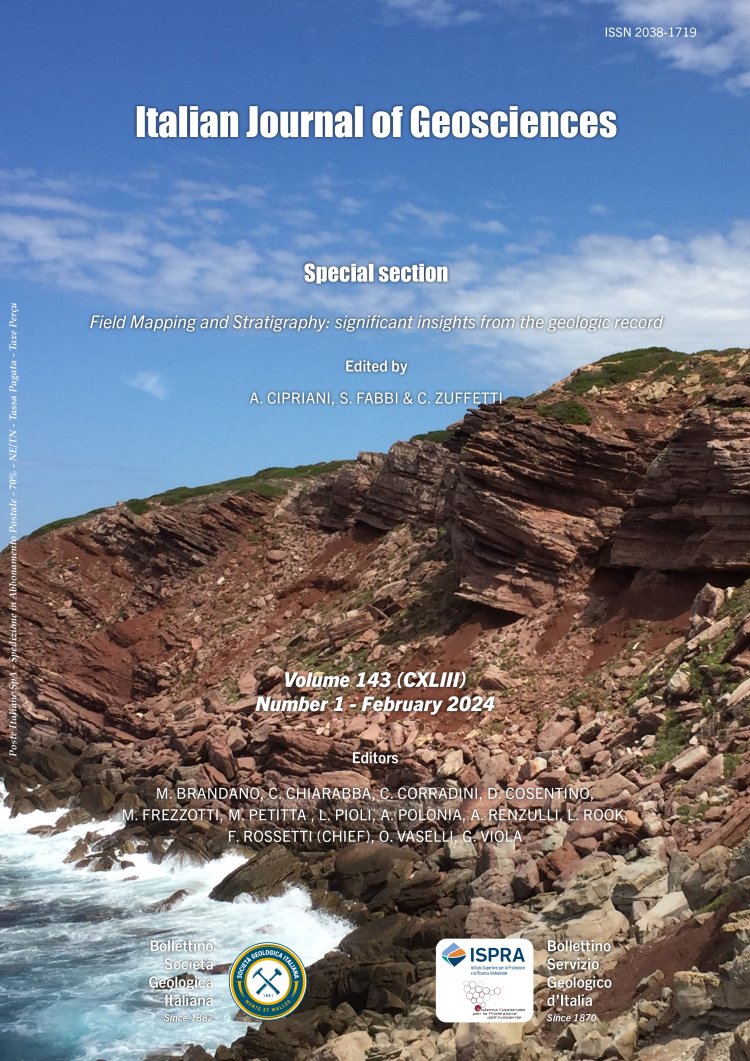
Tectono-stratigraphic evolution of a deep-water foreland basin: a case study from the Marnoso-arenacea basin, central Italy
Luca Pasqualone1, Francesco Brozzetti2-3, Francesco Mirabella1, Lucina Luchetti4, Anna Chiara Tangari2 & Massimiliano R. Barchi1-3
1Dipartimento di Fisica e Geologia, Università di Perugia.
2DiSPUTer, Università “G. d’Annunzio”, Chieti-Pescara.
3Centro InteRUniversitario per l’Analisi SismoTettonica tridimensionale (CRUST), Italy.
4Arta Abruzzo, Dipartimento di Chieti.
Corresponding author e-mail: luca.pasqualone@studenti.unipg.it
Volume: 143 (2024) f.1
Pages: 105-129
Abstract
An integrated study of the Marnoso-arenacea formation (FMA - Central Italy), based on a stratigraphic and structural-geological mapping constrained through extensive biostratigraphic and petrographic sampling, allowed us to investigate the evolution of the outer portion of the Apennine foreland basin system and to frame it in the context of the Miocene orogenic accretion.
The lithostratigraphic analysis led to subdivide the turbidite succession into two clearly distinguishable units, namely Valtopina and Vittiano. In turn, the succession of the Valtopina has also been subdivided into three sub- units achieving a strong refinement of the stratigraphy compared to the pre-existing cartography and leading to the elaboration of a new geological map of the area.
The biostratigraphic study of the nannofossils assemblages allowed us to locate the onset of the turbidite sedimentation very close to the Langhian-Serravallian boundary. The Valtopina unit has been attributed to late Langhian-middle Serravallian and the Vittiano unit to the late Serravallian. The Valtopina unit consists of a complex assemblage of: i) alpine- and apennine-fed siliciclastic turbidites, ii) south-west supplied hybrid arenites, and iii) calcarenites sourced from southern inputs. On the contrary, the Vittiano unit is characterised by the absence of carbonatoclastic turbidites, a general predominance of pelitic-arenaceous facies, and the prevalence of medium to thin-bedded fine-grained sandstones showing a marked thinning-up trend.
The petrographic analysis of the arenites has highlighted that, within the entire succession, quartz-feldspathic composition prevails. However, the general upward enrichment in sedimentary rock fragments suggests a progressive increase of the transversal inputs from the SW.
Our geological survey has evidenced an east-verging fold and thrust structure and two main NW-SE to N-S striking thrusts. These latter are subdivided into segments that show an én échelon arrangement or are separated by transversal tear faults. They subdivide the study area into three thrust sheets, whose internal geometry is characterised by asymmetrical folds, with 2 to 4 km wavelength. At the eastern border of the outcropping area, the turbidite succession shows reduced thickness and the upper Serravallian FMA is directly juxtaposed to the top of the underlying Meso-Cenozoic multilayer (Burdigalian Bisciaro fm) or to a strongly reduced Schlier fm.
The true geometry and kinematics of such contact is still unclear, due to the poor quality of the outcrops. We speculate that this feature could be related to the presence of a flexural forebulge unconformity, which in Serravallian time was possibly located in correspondence of the present-day western flank of the Umbria-Marche ridge. The SW- dipping foreland ramp might have also been affected by syn-orogenic extensional faults, as commonly observed in similar environments worldwide.
The analysed case-history is representative of syn-tectonic, strongly mobile foreland basin, filled by a multi- sourced turbidite succession in a complex tectono-sedimentary setting. Our study also demonstrates that detailed analysis of a limited portion of a basin can give useful insights on its overall setting and evolution.
Keywords
Get Full Text Supplementary Material